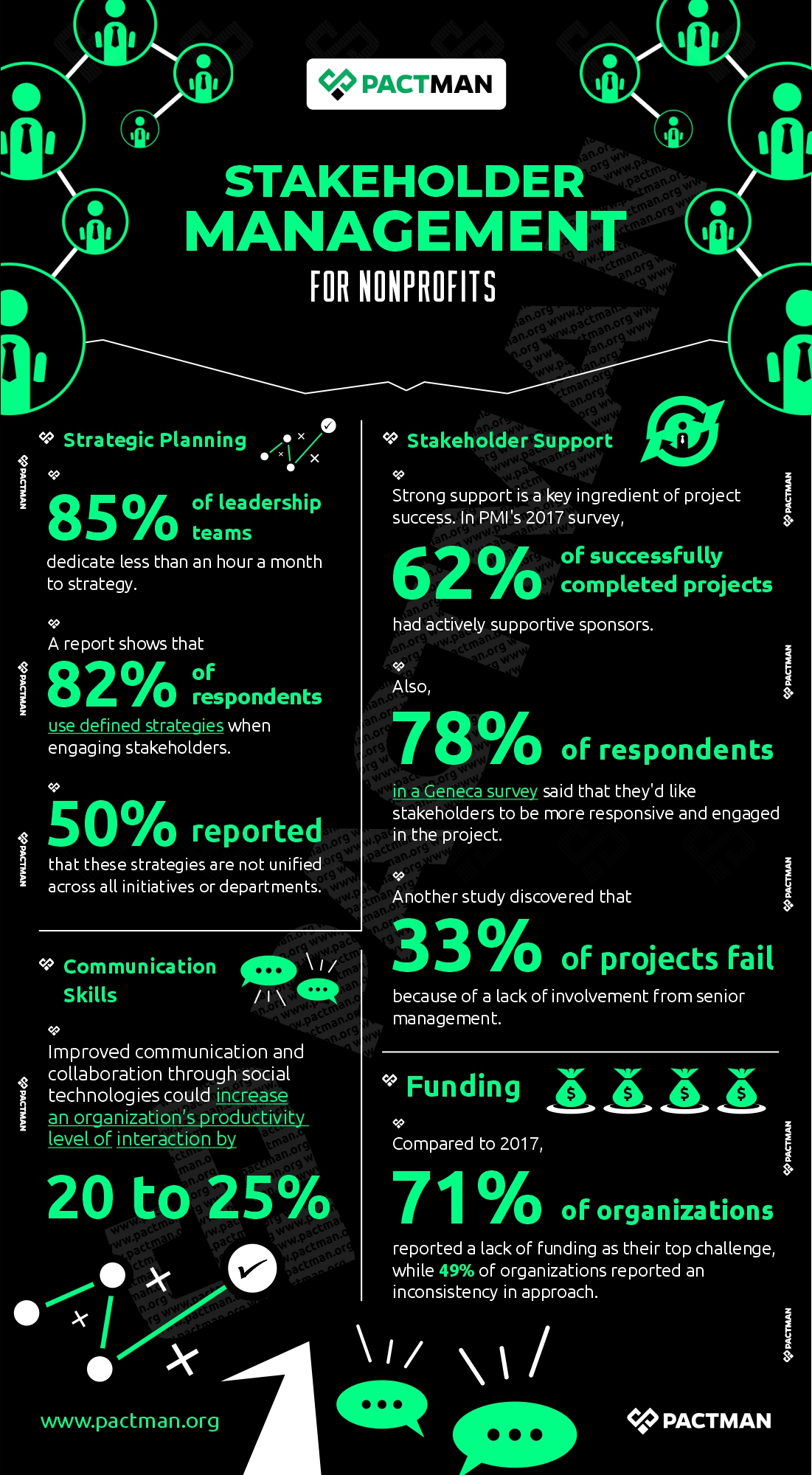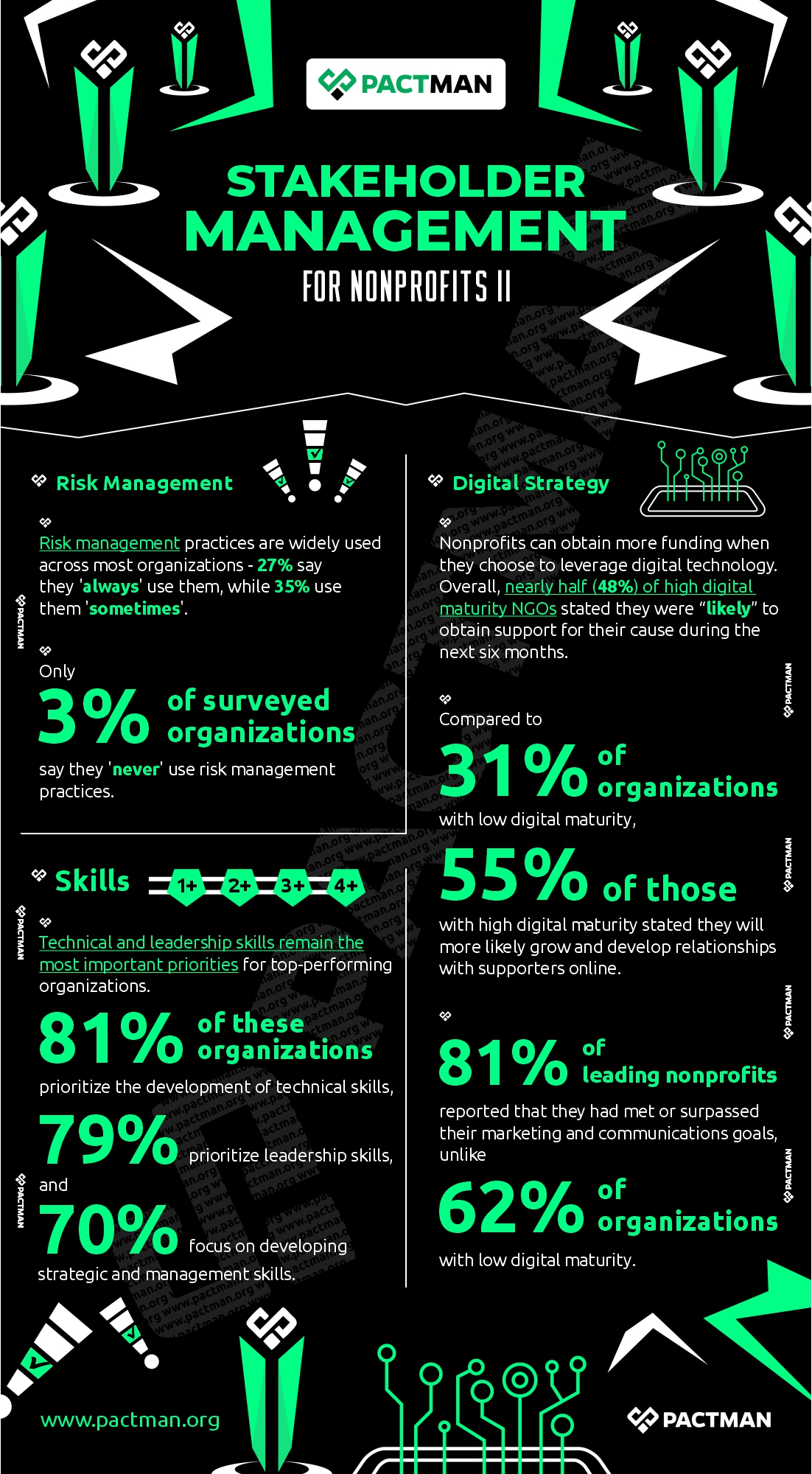I
Introduction
Nonprofit organisations operate in complex environments with multiple stakeholders, such as funders, government officials, volunteers, and participants. As a result, prioritising stakeholder management is a non-negotiable demand.
Also, nonprofit organisations depend on their stakeholders for resources and legitimacy. Because these streams aren’t always predictable or under control, stakeholders can add uncertainty to the nonprofit sector. Therefore, managing and monitoring stakeholder relationships is essential.

From a focal point, the stakeholders evaluate their associations with non-profit organisations. This is by gauging the extent to which their expectations are fulfilled and their relationship with the organisation.
Hence, stakeholder expectations and assessments must be guided by strategic management, which goes beyond simply responding to stakeholders. By and large, nonprofits can begin by influencing expectations to match their values, missions, and capabilities. In addition, NGOs can effectively position themselves to be viewed as effective organisations that respond to the needs of stakeholders and the public.
II
Who are Stakeholders and What is Stakeholder Management?
Stakeholders are any group or individual who can affect or be affected by the achievement of an organisation’s objectives. Consequently, these entities can impact an organisation’s sustainability goals. NPOs are viewed as effective when they embrace responsiveness and accountability.
Stakeholder management is the process of managing the needs and expectations of all internal and external stakeholders. To foster relationships and develop win-win solutions, effective nonprofits can create both formal and informal mechanisms to handle conflicting stakeholder pressures.

Essentially, 3 key nonprofit stakeholder groups can impact an organisation’s sustainability. They are; donors, members, and volunteers.
While stakeholder groups may differ for every nonprofit, the leaders of these organisations must comprehend their unique set of stakeholders and their potential impact on the leaders’ actions. Likewise, nonprofits can establish processes that can impact the organization’s long-term financial viability.
Without a doubt, an NGO’s performance and, consequently, its long-term financial viability heavily relies on its stakeholders. Also, a nonprofit’s reputation and level of community acceptance are impacted by external stakeholders. However, an organisation’s performance is often impacted by its internal stakeholders.
III
Critical Statistics on Stakeholder Management
In this section, we will consider critical statistics on stakeholder management to guide nonprofits in strategic decision-making.
a. Strategic Planning
85% of leadership teams dedicate less than an hour a month to strategy. According to a report, 82% of respondents use defined strategies when engaging stakeholders. Also, 50% reported that these strategies are not unified across all initiatives or departments.

b. Communication Skills
Improved communication and collaboration through social technologies could increase an organisation’s productivity level of interaction by 20 to 25%.
c. Support
Strong support is a key ingredient of project success. In a PMI survey, 62% of completed projects had actively supportive sponsors. Also, 78% of respondents in a Geneca survey said that they’d like stakeholders to be more responsive and engaged in the project. Another study discovered that 33% of projects fail because of a lack of involvement from senior management.

d. Risk Management
Risk management practices are widely used across most organisations – 27% say they ‘always’ use them, while 35% use them ‘sometimes’. Only 3% of surveyed organisations reported the absence of risk management practices.
e. Funding
71% of organisations reported a lack of funding as their top challenge, while 49% of organisations reported an inconsistency in approach.
f. Skills
Technical and leadership skills constitute the primary priorities across top-performing organisations. 81% of these organisations are more concerned about the development of technical skills, 79% emphasise leadership skills, and 70% prioritise developing strategic and management skills.
g. Digital Strategy
Nonprofits can obtain more funding when they choose to leverage digital technology. Overall, nearly half (48%) of high digital maturity NGOs stated they were “likely” to obtain support for their cause during the next six months.
Also, compared to 31% of organisations with low digital maturity, 55% of those with high digital maturity stated they will more likely grow and develop relationships with supporters online. Lastly, 81% of leading nonprofits reported that they had met or surpassed their marketing and communications goals, unlike 62% of organisations with low digital maturity.
IV
Effective Approach to Stakeholder Management
Organisations that have the most reputable value across all performance dimensions are known to prioritise stakeholder management. Even more, nonprofits can become more successful and resilient when they develop strategies that benefit all stakeholders. In addition, NGOs can set up procedures for putting these measures into practice.

When effective measures are put in place, it lessens the likelihood of detrimental catastrophes like community protests, decline in donor and stakeholder retention, and volunteer participation among others. Furthermore, a stakeholder-based approach to nonprofit management can improve sustainability.
In this section, we will highlight the top 3 most effective approaches to stakeholder management.
a. Stakeholder thinking
Stakeholder thinking is a way of looking at an organisation’s actions from the perspective of its stakeholders. Essentially, stakeholder groups promote the organisation’s operations because they have a stake in it.
By and large, the theory emphasises a multiperspective view of the organisation as an object of influence. According to this theory, an organisation’s ability to succeed depends on how well its stakeholders are managed and assessed. Also, for a nonprofit to be successful and long-lasting, attention must be given to all parties involved. This goes beyond just those that have an impact on or are impacted by the operations of the organisation.
To sum up, the goal of the strategic thinking theory is to create an organisational strategy that effectively represents the interests of stakeholders.
b. Stakeholder analysis
Stakeholder analysis seeks to identify and map out the major stakeholders. Also, this analysis seeks to observe the dynamics amongst identified stakeholders.
The identification of stakeholders is a fundamental component as it provides a good understanding of how to run a successful nonprofit. This identification serves as the foundation for stakeholder management. Hence, stakeholder analysis should be viewed as the foundation for ethical organisational strategy.
The parties involved in an organisation’s operations both influence and are influenced by its goals and purposes. Therefore, stakeholder management aims to strike a balance between the divergent interests and expectations of various stakeholders. According to the theory, there is a greater overall impact on an organisation’s performance when the interests of a larger group of stakeholders are taken care of, as opposed to just a few main actors.
Firstly, organisations should emphasise the significance of stakeholder partnerships in stakeholder management. Also, organisations should put more effort into encouraging the shared objectives of their stakeholders than trying to balance the demands and expectations of various stakeholders.
c. Stakeholder engagement and value creation
Long-term value creation and stakeholder relationships have become more central to research on stakeholder management. In contrast to producing instant benefit, value is thought to be created through building mutual relationships.
Though this perception may be considered outdated, more recent studies on stakeholder theory measure organisational performance in terms of the utility, or value, that is created for and acknowledged by stakeholders.
Stakeholder management has historically been understood as a means of handling risks and controlling the stakeholder relationships of an organisation through various practices. Consequently, stakeholder research places a lot of emphasis on the creation and dissemination of value.
Value creation should benefit all major stakeholders equally, so long as no one is given preference over another. Likewise, the stakeholder approach views how groups or individuals are affected by organisational functions, or how these groups affect the organisation.
This theory opines that nonprofits function within a stakeholder network, which is made up of numerous interconnected actors. Hence, it emphasises that the organisation is not always the focal point to which all stakeholders connect. Rather, it is one link in a larger grouping of actors.
V
Effective Stakeholder Management Practices for Nonprofits
As earlier stated, a nonprofit’s ability to remain financially sustainable depends on its stakeholders. Thus, a nonprofit may run the risk of going bankrupt if it relies too heavily on one group of stakeholders over another.
Organisational leaders need to create strategies that work for managing these groups of individuals. By and large, stakeholder management is an effective approach that can be used to influence the financial sustainability of an organisation.

To accomplish their goals, nonprofits seeking to increase financial sustainability may need to strengthen their bonds with stakeholders by using a variety of engagement techniques. Here are a few of these techniques.
a. Employ collaborative planning
Most nonprofits do not involve their stakeholders in their sustainability and strategic planning initiatives. This can result in a lack of participation as some stakeholders may become less committed. Overall, it can impact the long-term viability of an organisation.
Also, the way stakeholders view an organisation can have an impact on their involvement. This in turn can impact the calibre of stakeholder engagement initiatives.
Stakeholder perception tends to shift in response to perceived needs, vision, and communication process among others. To facilitate stakeholder engagement through negotiation, nonprofit leaders should employ collaborative planning tools that facilitate value communication. By doing so, nonprofits can:
(a) evaluate the range of stakeholder values;
(b) identify bottlenecks;
(c) find compromises; and
(d) identify trade-offs.
This management practice emphasises the connection between strategic planning and stakeholder engagement initiatives.
b. Promote transparency
To improve relationships with stakeholders, nonprofit leaders can employ transparency as an effective strategy. Because stakeholders base their opinions of an organisation on indicators, nonprofit leaders who want to foster trust and communication with stakeholders should make these indicators easily accessible.
Examples of organisational indicators of quality include mission statements, self-evaluations, websites, printed materials, fundraising efforts, annual reports, and program descriptions. In a similar vein, communication and transparency increase stakeholder trust in an organisation.
c. Leverage social media
In today’s globalised environment, nonprofit leaders can capitalise on digital platforms to enhance their engagement. Nonprofit leaders may employ digital platforms to enhance their responsiveness to stakeholders. The aim is to establish and preserve connections that may have an impact on the financial viability of the organisation.
Digital platforms make it possible for people to communicate directly and freely with one another by providing real-time, inexpensive, and generally accessible transmissions. Likewise, there are several benefits of digital platforms for nonprofits. It can improve stakeholder collaboration and communication and consequently promote relationship- and engagement-building initiatives.
Furthermore, social media sites like Facebook and Twitter can allow nonprofits to recognise and maintain meaningful stakeholder relationships. It allows leaders to interact, communicate, and work together with their diverse stakeholders.
d. Develop stakeholder engagement strategies
Nonprofits can leverage direct stakeholder engagements to provoke opportunities that could enhance organisational sustainability and performance. If nonprofit leaders hope to influence changes that can impact their organisation’s financial sustainability, they must engage stakeholders continuously through stakeholder engagement strategies. These strategies should be inclusive, dynamic, and responsive.
Also, nonprofits should prioritise stakeholders’ concerns, objections, advice, experiences, expectations, needs, preferences, perceptions, perspectives, and beliefs. In addition, inputs, feedback, responses, recommendations, suggestions, and other crucial information relevant to the success of the organisation” should be elicited through stakeholder engagement. The objective is to encourage dialogue that fosters mutual understanding and a common goal.
Organisational leaders should strive for interactive stakeholder engagement and create useful shared content that is complementary to all stakeholders.
In summary, stakeholder engagement strategies comprise a collection of group and cooperative initiatives aimed at promoting the general well-being of the organisation.
e. Sustain stakeholder strategy by implementing a system
For a strategy to be effective, it must be able to outlast the tenure of any one executive. Primarily, this means organisations must consider two basic things. Firstly, they must ensure everyone in the organisation is aware of the initiative, their part in it, and how their goals affect all stakeholders. Secondly, structured procedures for decision-making and implementation should be established.
f. Maintain Stakeholder privacy
Presently, with more laws protecting people’s right to privacy and information, it is even more important for an organisation to have a well-defined stakeholder management plan and procedures. The stakes are high and even on the increase. Hence, nonprofits should adopt a methodical, controlled approach to stakeholder management.
Stakeholders are often viewed as influencers because they can impact other people’s behaviour. Therefore, organisational leaders should exercise a great deal of discretion in directing the operations and activities of these individuals.
Also, a nonprofit board of directors constitutes important stakeholders due to their links to the community and the outside world. This can be used to influence the organisation’s capacity to generate funds. By and large, the level of influence that different stakeholders make to bring about change within the organisation varies along with the roles they play.
In conclusion, stakeholder interactions should be centered around three areas: (a) building trust and networking; (b) formal interactions; and (c) an atmosphere of cooperation, adaptation, and dedication among stakeholders.
Now more than ever, nonprofit leaders must use sustainability reporting as a tool to update stakeholders on their operations and outcomes. This helps to encourage legitimacy and accountability as cooperative stakeholder engagements can increase transparency.
VI
Top Stakeholder Management Tools for Nonprofits
In this section, we will consider some of the most effective stakeholder management software for nonprofits.

1. Tractivity
Tractivity is a robust software system that was created with stakeholders in mind. Primarily, the tool lets you handle all facets of your consultation and stakeholder engagement efforts. Effectively, you can map, engage, comprehend, and deliver compelling insights and better results.
With Tractivity’s comprehensive solution for managing stakeholder relationships, nonprofits can centralize stakeholder data, manage relationships efficiently, and produce better results.
Tractivity offers a full suite of features that facilitate best practices for engaging stakeholders. As a result, nonprofits can deliver unparalleled reporting and foster deeper engagements.
2. Simply Stakeholders
Stakeholder relationship management software, Simply Stakeholders, incorporates decades of experience in stakeholder engagement into a single, easy-to-use tool. Hence, you can keep your projects moving forward and also manage intricate relationships.
All it takes to reduce social risk and maximise impact is staying in touch with stakeholders. Likewise, this simple API integration lets you simplify your approach to stakeholder management with your existing communications and tech tools. Also, it’s very easy to integrate Simply Stakeholders with other systems.
3. Affnetz
Integrated into a feature-rich CRM system, the Affnetz Stakeholder Database software allows you to monitor the well-being of your nonprofit’s stakeholders in great detail.
With the help of Affnetz, your nonprofit can see every action taken by stakeholders throughout the whole organisation. Even more, stakeholder categories like donors, board members, volunteers, campaign cabinet, staff, and/or beneficiaries can all be divided into groups. Therefore, you can quickly search for and view the different stakeholder groups as they are all displayed at the top of the screen.
The Affnetz Stakeholder CRM is the central information source for several interconnected Affnetz functions. Also, what distinguishes Affnetz from other nonprofit software is its smooth integration. By employing this tool, you can lower inefficiencies, raise morale, and increase effectiveness for your nonprofit.
Conclusion
Stakeholder management provides a great way to create a solid foundation for stakeholder engagement. It ensures that an organisation devotes time to identifying, ranking, and evaluating stakeholders and their interests.
Also, by having a good understanding of stakeholders and a solid engagement plan that is strategic, clear, and prioritised, nonprofits can minimize risks, align organisational objectives, eliminate delays, and build and maintain relationships.



4 Responses